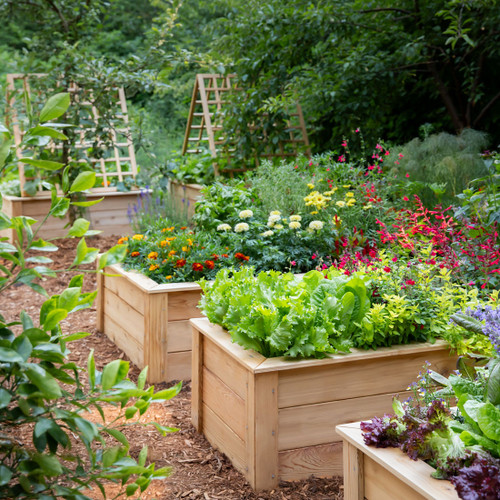Understanding raised bed basics
Raised beds are elevated garden plots that sit above the ground, typically enclosed by a frame to hold the soil in place. These structures allow gardeners to create a controlled growing environment, making it easier to manage soil quality, drainage, and plant spacing.
Raised garden beds are popular because they offer a versatile solution for both small and large gardens, enabling efficient use of space and providing better access for planting, weeding, and harvesting. This guide aims to help you understand the different benefits, products, and materials associated with raised bed gardening.
Benefits of raised beds
Raised bed gardening can significantly enhance your growing efforts. By elevating the garden bed, excess water drains more effectively, preventing waterlogged soil that can lead to root rot and other plant diseases. This elevated design also allows for better soil aeration, which promotes healthy root development and encourages robust plant growth.
Another key benefit is the reduction in weed growth and soil compaction. With raised beds, you have better control over the soil environment, reducing the likelihood of weeds taking root. Additionally, because the soil in raised beds is less prone to being compacted by foot traffic, plants are able to access nutrients and water more easily, leading to higher yields and healthier crops. This also means less time spent on weeding and soil preparation, allowing gardeners to focus on nurturing their plants.
Raised bed gardening also enhances accessibility and convenience. The elevated height of the beds reduces the need for bending and kneeling, making gardening easier on the back and knees. This ergonomic design is especially beneficial for individuals with mobility issues or those who simply prefer a more comfortable gardening experience. Additionally, raised beds can be placed in locations with poor soil conditions, such as rocky or clay-heavy areas, allowing gardeners to create optimal growing conditions without extensive soil amendments.
Understanding types of raised garden beds
Classic raised garden beds or garden boxes are designed to rest directly on soil since they are open to the ground beneath. This provides plants with access to greater soil depth while keeping gardens neat, aligned, and easy to maintain.
Raised bed planters are ideal for small spaces or urban gardens. Planters have integrated bottoms, offering the flexibility to create beautiful and productive gardens on patios, balconies, and more. They are more portable than raised beds and offer perfect alternatives for herb gardens, vegetables, flowers, and more.
Design your floral paradise with raised flower beds, which help showcase your favorite blooms and make gardening more accessible. Add trellises for vining plants to explore vertical gardening.
Grow fresh produce right at your doorstep with raised vegetable beds, designed to maximize yield and ease of harvest. Vegetables do best in longer raised beds with popular sizes being 3 x 6 feet and 4 x 8 feet. Longer configurations make installing irrigation easier.
Cedar raised garden beds are crafted from durable cedar wood, which is naturally resistant to rot and pests, providing a long-lasting and stylish solution for your garden.
Understanding raised bed materials
When constructing raised garden beds, several materials are commonly used. Each material has its advantages, so the choice often depends on aesthetic preference, budget, and specific gardening needs.
Wood is a popular choice, particularly cedar and redwood, due to their natural resistance to decay and insects, making them both durable and aesthetically pleasing. Wood is highly favored for raised garden beds due to its natural insulating properties, which help maintain optimal soil temperatures for plant growth. Additionally, it can be easily customized in terms of size and shape, allowing for creative and tailored garden designs. The warmth and organic look of wood also blend seamlessly with garden landscapes, enhancing both functionality and visual appeal.
For those seeking a more contemporary look, metal such as galvanized steel or aluminum provides a sleek, modern appearance and exceptional longevity, withstanding harsh weather conditions. Many metal options come in a variety of shapes, including ovals and rectangles with curved edges.
Composite is another robust option, providing excellent stability and insulation for plant roots. Composite beds are made from a blend of wood fibers and plastic, combine the best features of wood and synthetic products, offering durability and minimal maintenance.
Recycled plastic beds are another eco-friendly option gaining popularity in garden design. Made from non-toxic, food grade HDPE plastic materials, these beds offer exceptional durability and resistance to weathering, while also reducing environmental impact. They are lightweight yet sturdy, making them easy to move and install, and require minimal maintenance compared to traditional materials.
Choosing the right raised bed for your space
Choosing the right raised bed for your yard involves considering several key factors to ensure it meets your gardening needs and fits well within your outdoor space. Start by assessing the size of your garden area and the types of plants you intend to grow. For smaller spaces or urban gardens, compact raised bed planters can maximize your growing area without overwhelming your space. Conversely, larger yards may benefit from expansive raised garden boxes that allow for more diverse plantings, including vegetables and flowers.
Material choice is another crucial factor. Wood offers a classic look and natural insulation but requires periodic maintenance to prevent decay. Metal and composite materials provide durability and low upkeep, with metals offering a modern aesthetic and composites combining the best features of wood and plastic. For eco-conscious gardeners, recycled plastic beds combine sustainability with resilience. Each material has its unique attributes, so select one that aligns with your aesthetic preferences, budget, and long-term maintenance commitment.
Finally, consider the height and design of the raised bed to ensure it complements your gardening habits and physical comfort. Beds that are too high may be difficult to reach, while those too low might not offer the ergonomic benefits you’re looking for. Opt for designs that allow easy access to plants and fit well with your overall garden layout.






